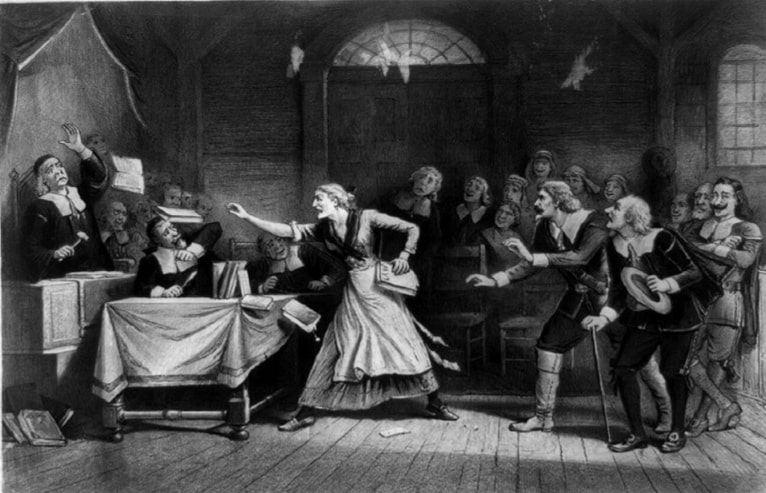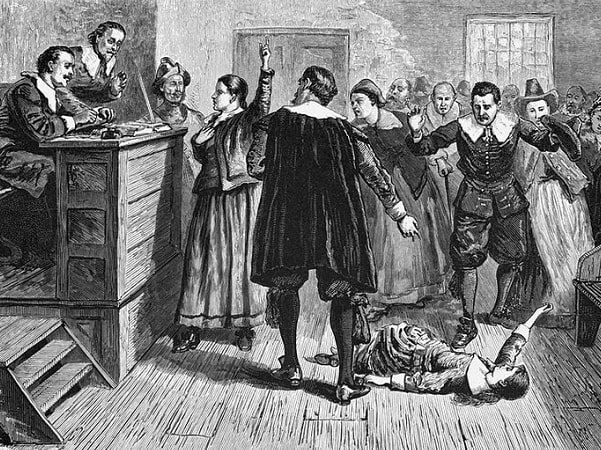Introduction: In this article, Melissa Davenport Berry writes about the Salem witch trials of 1692, focusing on objects from that time preserved to this day. Melissa is a genealogist who has a blog, AnceStory Archives, and a Facebook group, New England Family Genealogy and History.
With Halloween approaching, it is that time of year again when the world descends upon Salem, Massachusetts. If you should make that pilgrimage be sure to visit the Peabody Essex Museum (PEM) and experience the Salem Witch Trials: Restoring Justice exhibition gallery running through November 26.
According to the PEM’s website:
“The exhibition tells this story [Salem’s witch trials] through court documents and authentic historic objects presented as tangible fragments directly tied to people in Salem and nearby communities in the late 17th century. A handwritten petition, a carved loom, a walking stick – each illuminates an aspect of individuals who lived through Salem’s witch trials and serves as a reminder of the real people impacted by these harrowing events.”

In the next few weeks, I will cover the relics on exhibit associated with the infamous witch trials. Today I investigate a married couple charged with witchcraft, Philip (or Phillip) and Mary English, who managed to escape the rope.
Much of the narrative on Mary is furnished in the diary entries of Dr. William Bentley (1759-1819), born to Joshua Bentley and Elizabeth Paine.
Dr. Bentley was the pastor of the East Church in Salem. He was a raconteur, contributing weekly to the Salem Gazzette, and an avid collector of 17th century artifacts. Along with this collection, he furnished colorful anecdotes passed down through the generations.
In his diary, Dr. Bentley wrote about a sampler in his collection made by Mary Hollingsworth – the future Mrs. English:
“She has left a specimen of her needlework in her infancy, or youth. It is about 2 feet by 9 inches, like a sampler. It concludes with an alphabet & her name, in the usual form. The figures are diversified with great ease & proportion, & there are all the stitches known to be then in use, & an endless variety of figures in right lines, after no example of nature.”
Here is the sampler in the PEM exhibition made by Mary Hollingsworth.
Another of the relics in the Peabody Essex Museum exhibition with a connection to Dr. Bentley is the (Mary and Philip) English chair, circa 1674, attributed to joiner Samuel Beadle Jr. of Salem.
The chair was a gift from Mary Robins Crowninshield to the Essex Institute in 1908. Dr. Bentley lived with Mrs. Hannah (Carlton) Crowninshield, widow of Jacob Crowninshield and the great-grandmother of the donor of the chair.
The couple lived in what is now known as the Crowninshield-Bentley House. Built in 1727 by Captain John Crowninshield at 106 Essex Street, it was moved to the PEM site on 126 Essex Street, Salem, Massachusetts. Capt. John was the father of Jacob, husband to the later-widowed Mrs. Hannah (Carlton) Crowninshield.
Another source for Dr. Bentley was Susannah Hathorne Crowninshield, daughter of Daniel Hathorne and Rachel Phelps and the wife of John Crowninshield, son of Jacob and Hannah Crowninshield. More on the family connections in part 2 of this story.
I found an interesting article in the Winchester News about the English chair.
This article reported:
Mary English’s chair has been added to the collections of the Essex Institute in Salem. It is a plain, square, high-back wooden chair. On it is this strange inscription: “It shall be told of her. Mary English, April 22, 1692.”
An examination of the institute records reveals a remarkable story which explains the meaning of the phrase: “It shall be told of her.”
In the diary of Dr. [William] Bentley is this entry:
“Ordered the chair received from the English family in memory of 1692 to be painted green, and on the back ‘1692,’ upper slat; middle slat, ‘Mary English’; lower slat, ‘April 22,’ the time of her mittimus; on the front upper slat, ‘It shall be told of her.’”
In a chapter of his diary, Dr. Bentley tells the story of Mary English. She was the daughter of [William] Hollingsworth, a famous colonial merchant. She was exceptionally well educated for a woman of her time. She could write.
She married Philip English. He came here a small boy from the Isle of Jersey. By industry he became the largest ship owner of New England. Soon after he married Mary Hollingsworth he built a mansion, which was known for many years as “the English Great Howse.”
At 11 o’clock at night, April 22, 1692 (the date on the chair), sheriffs of Salem entered the English house and placed Mrs. English under arrest for witchcraft. The Englishes had not the slightest warning of the terrible charge. [Mr.] English paced the floor all night. Mrs. English refused to rise. The sheriffs remained on guard in the bedroom all night.
In the morning Mrs. English insisted on putting her house in order and in directing her servants what to do until her return. She had 20 servants.
The sheriffs took Mrs. English to the Cat and Wheel, a tavern, which the authorities used for a prison and court room, because the town jail was crowded with witchcraft suspects. [Note: In her book In the Devil’s Snare: The Salem Witchcraft Crisis of 1692, Mary Beth Norton asserts that Mary was probably confined to Thomas Beadle’s Tavern.]
[Philip] English himself was arrested for witchcraft. He and his wife were taken to Boston because the Salem jails were crowded. They were released on parole in Boston. The Sunday before they were to return to Salem for trial they attended church in Boston. The Rev. Joshua Moody preached. His text was: “If they persecute ye in one city flee to another.”
After church friends visited the Englishes in jail in Boston and urged them to fly. They refused, declaring they were innocent and God would protect them.
Finally they consented to escape. At night they left the Boston jail, entered a carriage and were driven to New York.
To be continued…
Explore over 330 years of newspapers and historical records in GenealogyBank. Discover your family story! Start a 7-Day Free Trial
Note on the header image: witchcraft trial at Salem Village. The central figure in this 1876 illustration of the courtroom is usually identified as Mary Walcott. Credit: Wikimedia Commons.
Related Articles:
